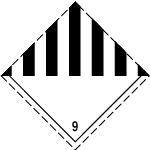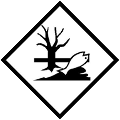SAFETY DATA SHEET
Durcupan Water Soluble Embedding Kit - Part D
1. IDENTIFICATION
Product Identifiers
Product Name:
Durcupan Water Soluble Embedding Kit - Component D
Other Names:
Durcupan H2O Solution Component D
Product Number(s):
C665
CAS Number:
84-74-2
Recommended use of the chemical and restriction on use
Laboratory use.
Company Details
ProSciTech Pty Ltd
11 Carlton Street
KIRWAN QLD 4817
Australia(07) 4773 9444www.proscitech.com
11 Carlton Street
KIRWAN QLD 4817
Australia(07) 4773 9444www.proscitech.com
Emergency Contact Details
ProSciTech Pty Ltd
11 Carlton Street
KIRWAN QLD 4817
Australia(07) 4773 9444www.proscitech.com
11 Carlton Street
KIRWAN QLD 4817
Australia(07) 4773 9444www.proscitech.com
2. HAZARDS IDENTIFICATION
Classification of the substance or mixture
GHS08 health hazard
Repr. 1B H360 May damage fertility or the unborn child.
Repr. 1B H360 May damage fertility or the unborn child.
Label Elements

Signal Words
Danger
Hazard Statement(s)
May damage fertility or the unborn child.
Precautionary Statement(s)
Wear protective gloves/protective clothing/eye protection/face protection.
Obtain special instructions before use.
Do not handle until all safety precautions have been read and understood.
IF exposed or concerned: Get medical advice/attention.
Store locked up.
Dispose of contents/container in accordance with local/regional/national/international regulations.
Obtain special instructions before use.
Do not handle until all safety precautions have been read and understood.
IF exposed or concerned: Get medical advice/attention.
Store locked up.
Dispose of contents/container in accordance with local/regional/national/international regulations.
Primary route(s) of entry
Not available.
Human Health
Inhalation:
Not available.
Ingestion:
Not available.
Eyes:
Not available.
Skin:
Not available.
Environment
Dispose of contents/container in accordance with local/regional/national/international regulations.
3. COMPOSITION/INFORMATION ON INGREDIENTS
Name
CAS No.
Content (w/w)
Classification
Dibutyl phthalate
84-74-2
-
-
4. FIRST AID MEASURES
Ingestion
If symptoms persist consult doctor.
Inhalation
Supply fresh air; consult doctor in case of complaints.
Skin Contact
Generally the product does not irritate the skin.
Eye Contact
Rinse opened eye for several minutes under running water.
Other Information
No further relevant information available.
5. FIREFIGHTING MEASURES
Suitable extinguishing equipment
Use fire extinguishing methods suitable to surrounding conditions.
HAZCHEM
Not available.
Special protective equipment and precautions for fire fighters
Keep respiratory protective device available.
6. ACCIDENTAL RELEASE MEASURES
Personal precautions, protective equipment and emergency procedures
Not required.
Environmental precautions
Inform respective authorities in case of seepage into water course or sewage system.
Dilute with plenty of water.
Do not allow to enter sewers/ surface or ground water.
Dilute with plenty of water.
Do not allow to enter sewers/ surface or ground water.
Methods and materials for containment and clean up
Absorb with liquid-binding material (sand, diatomite, acid binders, universal binders, sawdust).
Dispose contaminated material as waste according to item 13.
Ensure adequate ventilation.
Dispose contaminated material as waste according to item 13.
Ensure adequate ventilation.
7. HANDLING AND STORAGE
Precautions for safe handling
Ensure good ventilation/exhaustion at the workplace.
Open and handle receptacle with care.
Prevent formation of aerosols.
Open and handle receptacle with care.
Prevent formation of aerosols.
Conditions for safe storage
8. EXPOSURE CONTROLS/PERSONAL PROTECTION
Exposure Standards
Material
TWA ppm
TWA mg/m3
STEL ppm
STEL mg/m3
Dibutyl phthalate
NA
5 mg/m³
NA
NA
Engineering controls
Not available.
Personal protective equipment
Eye and face protection
Goggles recommended during refilling.
Skin protection
The glove material has to be impermeable and resistant to the product/ the substance/ the preparation.
Due to missing tests no recommendation to the glove material can be given for the product/ the preparation/ the chemical mixture.
Selection of the glove material on consideration of the penetration times, rates of diffusion and the degradation.
Material of gloves.
The selection of the suitable gloves does not only depend on the material, but also on further marks of quality and varies from manufacturer to manufacturer.
Penetration time of glove material.
The exact break through time has to be found out by the manufacturer of the protective gloves and has to be observed.
Due to missing tests no recommendation to the glove material can be given for the product/ the preparation/ the chemical mixture.
Selection of the glove material on consideration of the penetration times, rates of diffusion and the degradation.
Material of gloves.
The selection of the suitable gloves does not only depend on the material, but also on further marks of quality and varies from manufacturer to manufacturer.
Penetration time of glove material.
The exact break through time has to be found out by the manufacturer of the protective gloves and has to be observed.
Body protection
Keep away from foodstuffs, beverages and feed.
Immediately remove all soiled and contaminated clothing.
Wash hands before breaks and at the end of work.
Store protective clothing separately.
Immediately remove all soiled and contaminated clothing.
Wash hands before breaks and at the end of work.
Store protective clothing separately.
Respiratory protection
In case of brief exposure or low pollution use respiratory filter device. In case of intensive or longer exposure use self-contained respiratory protective device.
9. PHYSICAL AND CHEMICAL PROPERTIES
General information
Appearance
Colourless liquid.
Odour
Characteristic
pH
Neutral
Vapour Pressure
at 162 °C: 0.00002 hPa
Density
at 20 °C: 1.045 g/cm³
Boiling Point
340 °C
Melting Point
-35.8 °C
Solubility
Miscibility with
water at 20 °C: 0.1 g/l
water at 20 °C: 0.1 g/l
Specific Gravity of Density
Not determined.
Flash Point
188 °C
Flammable (Explosive) Limits
Lower: <0.1 Vol %
Upper: 1.97 Vol %
Upper: 1.97 Vol %
Ignition Temperature
390 °C
Formula
Not available.
10. STABILITY AND REACTIVITY
Reactivity
No further relevant information available.
Chemical stability
No decomposition if used according to specifications.
Possibility of hazardous reactions
No dangerous reactions known.
Conditions to avoid
No further relevant information available.
Incompatible materials
No further relevant information available.
11. TOXICOLOGICAL INFORMATION
Acute effects
No further relevant information available.
Eye contact
No irritant effect.
Skin contact
No irritant effect.
No sensitising effects known.
No sensitising effects known.
Ingestion
No further relevant information available.
Inhalation
No sensitising effects known.
Toxicity and irritation
LD/LC50 values relevant for classification:
84-74-2 dibutyl phthalate
Oral LD50 8000 mg/kg (rat)
Dermal LD50 20000 mg/kg (rabbit
84-74-2 dibutyl phthalate
Oral LD50 8000 mg/kg (rat)
Dermal LD50 20000 mg/kg (rabbit
12. ECOLOGICAL INFORMATION
Ecotoxicity
Very toxic for fish.
Persistence and degradability
No further relevant information available.
Bioaccumulative potential
No further relevant information available.
Other adverse effects
Water hazard class 2 (German Regulation) (Assessment by list): hazardous for water.
Do not allow product to reach ground water, water course or sewage system.
Danger to drinking water if even small quantities leak into the ground.
Also poisonous for fish and plankton in water bodies.
Very toxic for aquatic organisms.
Do not allow product to reach ground water, water course or sewage system.
Danger to drinking water if even small quantities leak into the ground.
Also poisonous for fish and plankton in water bodies.
Very toxic for aquatic organisms.
13. DISPOSAL CONSIDERATIONS
General information
Must not be disposed together with household garbage. Do not allow product to reach sewage system.
Uncleaned packaging:
Recommendation: Disposal must be made according to official regulations.
Recommended cleansing agents: Water, if necessary together with cleansing agents.
Uncleaned packaging:
Recommendation: Disposal must be made according to official regulations.
Recommended cleansing agents: Water, if necessary together with cleansing agents.
14. TRANSPORT INFORMATION
ADG label required


HAZCHEM
Not available.
UN Number
UN3082
Proper shipping name
3082 ENVIRONMENTALLY HAZARDOUS SUBSTANCE,
LIQUID, N.O.S. (dibutyl phthalate)
LIQUID, N.O.S. (dibutyl phthalate)
Transport hazard class
9 Miscellaneous dangerous substances and articles.
Packing group
III
Environmental hazard
Symbol (fish and tree)
Special precautions for users
Warning: Miscellaneous dangerous substances and articles.
Danger code (Kemler): 90
Stowage Category A
Danger code (Kemler): 90
Stowage Category A
Additional information
Transport/Additional information:
ADG
Limited quantities (LQ) 5L
Excepted quantities (EQ) Code: E1
Maximum net quantity per inner packaging: 30 ml.
Maximum net quantity per outer packaging: 1000 ml.
Transport category 3
Tunnel restriction code E
ADG
Limited quantities (LQ) 5L
Excepted quantities (EQ) Code: E1
Maximum net quantity per inner packaging: 30 ml.
Maximum net quantity per outer packaging: 1000 ml.
Transport category 3
Tunnel restriction code E
15. REGULATORY INFORMATION
Poisons Schedule Number
S10
Other Information
GHS label elements
The substance is classified and labelled according to the Globally Harmonised System (GHS).
GHS08
Signal word Danger
Hazard-determining components of labelling:
Dibutyl phthalate
Hazard statements.
Precautionary statements
Wear protective gloves/protective clothing/eye protection/face protection.
Obtain special instructions before use.
Do not handle until all safety precautions have been read and understood.
IF exposed or concerned: Get medical advice/attention.
Store locked up.
Dispose of contents/container in accordance with local/regional/national/international regulations.
The substance is classified and labelled according to the Globally Harmonised System (GHS).
GHS08
Signal word Danger
Hazard-determining components of labelling:
Dibutyl phthalate
Hazard statements.
Precautionary statements
Wear protective gloves/protective clothing/eye protection/face protection.
Obtain special instructions before use.
Do not handle until all safety precautions have been read and understood.
IF exposed or concerned: Get medical advice/attention.
Store locked up.
Dispose of contents/container in accordance with local/regional/national/international regulations.
16. OTHER INFORMATION
SDS preparation date
16 August 2023
Comments
This information is based on our present knowledge. However, this shall not constitute a guarantee for any specific product features and shall not establish a legally valid contractual relationship.
This Safety Data Sheet (SDS) has been prepared in compliance with the Preparation of Safety Data Sheets for Hazardous Chemicals Code of Practice February 2016. It is the user's responsibility to determine the suitability of this information for adoption of necessary safety precautions. The information published in this SDS has been compiled from the publications listed in Section 16: to the best of our ability and knowledge these publications are considered accurate. We reserve the right to revise Safety Data Sheets as new information becomes available. Copies may be made for non-profit use.